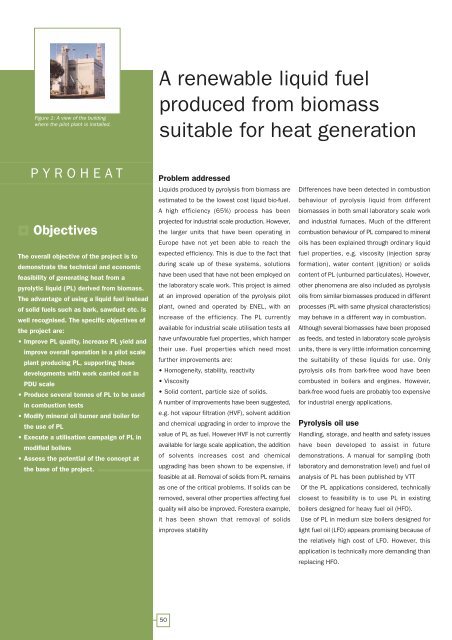European Bio-Energy Projects
European Bio-Energy Projects
European Bio-Energy Projects
You also want an ePaper? Increase the reach of your titles
YUMPU automatically turns print PDFs into web optimized ePapers that Google loves.
Figure 1: A view of the building<br />
where the pilot plant is installed.<br />
PYROHEAT<br />
Objectives<br />
The overall objective of the project is to<br />
demonstrate the technical and economic<br />
feasibility of generating heat from a<br />
pyrolytic liquid (PL) derived from biomass.<br />
The advantage of using a liquid fuel instead<br />
of solid fuels such as bark, sawdust etc. is<br />
well recognised. The specific objectives of<br />
the project are:<br />
• Improve PL quality, increase PL yield and<br />
improve overall operation in a pilot scale<br />
plant producing PL, supporting these<br />
developments with work carried out in<br />
PDU scale<br />
• Produce several tonnes of PL to be used<br />
in combustion tests<br />
• Modify mineral oil burner and boiler for<br />
the use of PL<br />
• Execute a utilisation campaign of PL in<br />
modified boilers<br />
• Assess the potential of the concept at<br />
the base of the project.<br />
A renewable liquid fuel<br />
produced from biomass<br />
suitable for heat generation<br />
Problem addressed<br />
Liquids produced by pyrolysis from biomass are<br />
estimated to be the lowest cost liquid bio-fuel.<br />
A high efficiency (65%) process has been<br />
projected for industrial scale production. However,<br />
the larger units that have been operating in<br />
Europe have not yet been able to reach the<br />
expected efficiency. This is due to the fact that<br />
during scale up of these systems, solutions<br />
have been used that have not been employed on<br />
the laboratory scale work. This project is aimed<br />
at an improved operation of the pyrolysis pilot<br />
plant, owned and operated by ENEL, with an<br />
increase of the efficiency. The PL currently<br />
available for industrial scale utilisation tests all<br />
have unfavourable fuel properties, which hamper<br />
their use. Fuel properties which need most<br />
further improvements are:<br />
• Homogeneity, stability, reactivity<br />
• Viscosity<br />
• Solid content, particle size of solids.<br />
A number of improvements have been suggested,<br />
e.g. hot vapour filtration (HVF), solvent addition<br />
and chemical upgrading in order to improve the<br />
value of PL as fuel. However HVF is not currently<br />
available for large scale application, the addition<br />
of solvents increases cost and chemical<br />
upgrading has been shown to be expensive, if<br />
feasible at all. Removal of solids from PL remains<br />
as one of the critical problems. If solids can be<br />
removed, several other properties affecting fuel<br />
quality will also be improved. Forestera example,<br />
it has been shown that removal of solids<br />
improves stability<br />
50<br />
Differences have been detected in combustion<br />
behaviour of pyrolysis liquid from different<br />
biomasses in both small laboratory scale work<br />
and industrial furnaces. Much of the different<br />
combustion behaviour of PL compared to mineral<br />
oils has been explained through ordinary liquid<br />
fuel properties, e.g. viscosity (injection spray<br />
formation), water content (ignition) or solids<br />
content of PL (unburned particulates). However,<br />
other phenomena are also included as pyrolysis<br />
oils from similar biomasses produced in different<br />
processes (PL with same physical characteristics)<br />
may behave in a different way in combustion.<br />
Although several biomasses have been proposed<br />
as feeds, and tested in laboratory scale pyrolysis<br />
units, there is very little information concerning<br />
the suitability of these liquids for use. Only<br />
pyrolysis oils from bark-free wood have been<br />
combusted in boilers and engines. However,<br />
bark-free wood fuels are probably too expensive<br />
for industrial energy applications.<br />
Pyrolysis oil use<br />
Handling, storage, and health and safety issues<br />
have been developed to assist in future<br />
demonstrations. A manual for sampling (both<br />
laboratory and demonstration level) and fuel oil<br />
analysis of PL has been published by VTT<br />
Of the PL applications considered, technically<br />
closest to feasibility is to use PL in existing<br />
boilers designed for heavy fuel oil (HFO).<br />
Use of PL in medium size boilers designed for<br />
light fuel oil (LFO) appears promising because of<br />
the relatively high cost of LFO. However, this<br />
application is technically more demanding than<br />
replacing HFO.

















